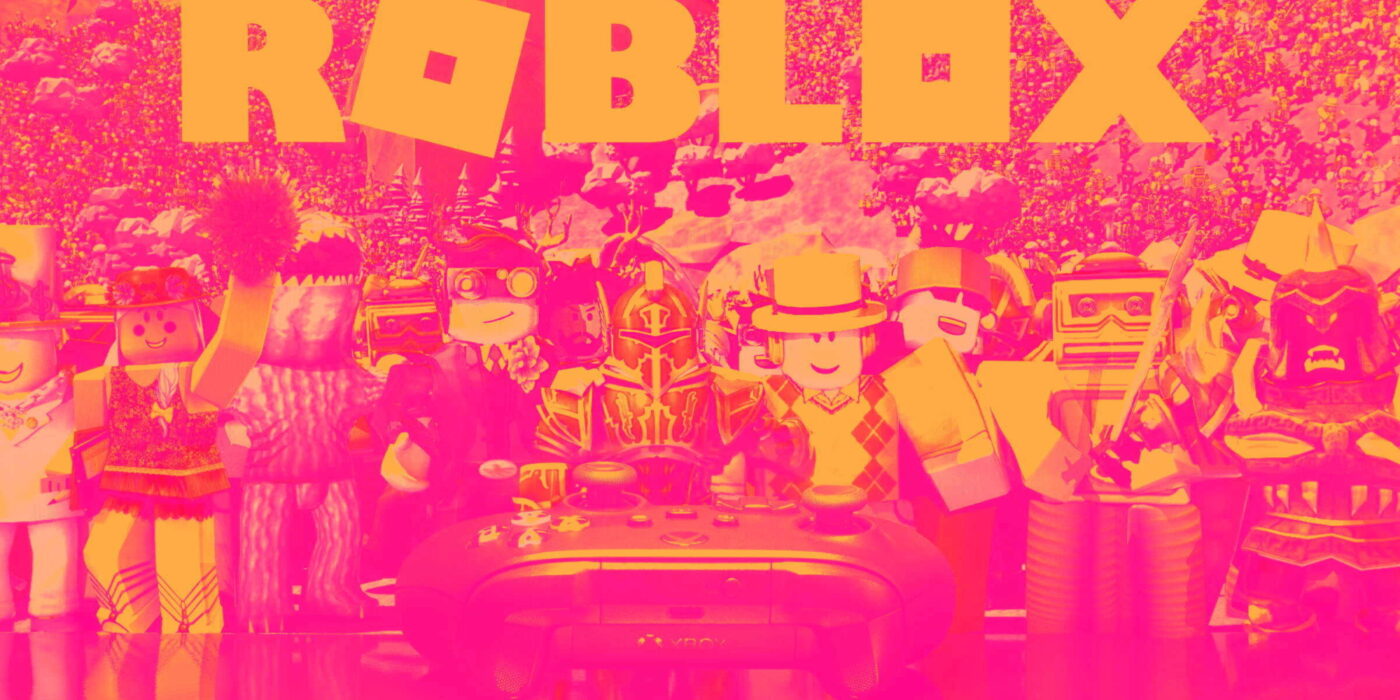Gaming metaverse operator Roblox (NYSE:RBLX) fell short of analysts' expectations in Q1 CY2024, with revenue up 22.3% year on year to $801.3 million. Next quarter's revenue guidance of $867.5 million also underwhelmed, coming in 7.6% below analysts' estimates. It made a GAAP loss of $0.43 per share, improving from its loss of $0.44 per share in the same quarter last year.
Roblox (RBLX) Q1 CY2024 Highlights:
- Revenue: $801.3 million vs analyst estimates of $806.2 million (slight miss)
- EPS: -$0.43 vs analyst estimates of -$0.53 (19.1% beat)
- Bookings Guidance for Q2 CY2024 is $885 million at the midpoint, below analyst estimates of $938.6 million
- Bookings Guidance for the full-year 2024 is $4,050 million at the midpoint, below analyst estimates of $4,225 million
- Gross Margin (GAAP): 24.1%, up from 16.8% in the same quarter last year
- Free Cash Flow of $191.1 million, up 145% from the previous quarter
- Daily Active Users: 77.7 million
- Market Capitalization: $24.97 billion
Best known for its wide assortment of user-generated content, Roblox (NYSE:RBLX) is an online gaming platform and game creation system.
Roblox is a multi-sided platform that connects players/users with creators/developers and other stakeholders like advertisers. It is one part operating system and one part app store. The ecosystem allows players to play a near infinite catalog of games, which is continuously being added to, as more players join the ecosystem and experiment with creating their own games and virtual items. Roblox provides creators/developers with proprietary tools to design and build experiences, games, items, and even other developer tools that can be monetized.
Roblox has its own currency, Robux, whereby users can deposit cash to purchase virtual items OR earn Robux by selling their own items or developer tools, which can be converted into actual currency. Adjacent stakeholders can take almost infinite forms – many not yet developed. Current examples are musicians performing virtual concerts or brands like Gucci or Nike creating digital experiences.
Video Gaming
Since videogames were invented in the 1970s, they have gradually taken more share of entertainment time. Ubiquitous mobile devices have powered a surge in “snackable” games that can be played on the go. Over time, games have developed more social engagement features where friends can play games together over the internet. The business models of games publishers have become less volatile due to digitization of distribution, in game monetization, and like Hollywood, an increasing dependence on surefire hit franchises. Covid driven lockdowns accelerated adoption and usage of videogames – a trend that has not slowed.
Roblox competes with other large video game makers such as Epic Games (private, creator of Fortnite), Minecraft (owned by Microsoft, NASDAQ:MSFT), Electronic Arts (NASDAQ:EA), Take Two (NASDAQ:TTWO, and Nintendo (TSE:7974).
Sales Growth
Roblox's revenue growth over the last three years has been mediocre, averaging 15.2% annually. This quarter, Roblox reported decent 22.3% year-on-year revenue growth, falling short of analysts' expectations.
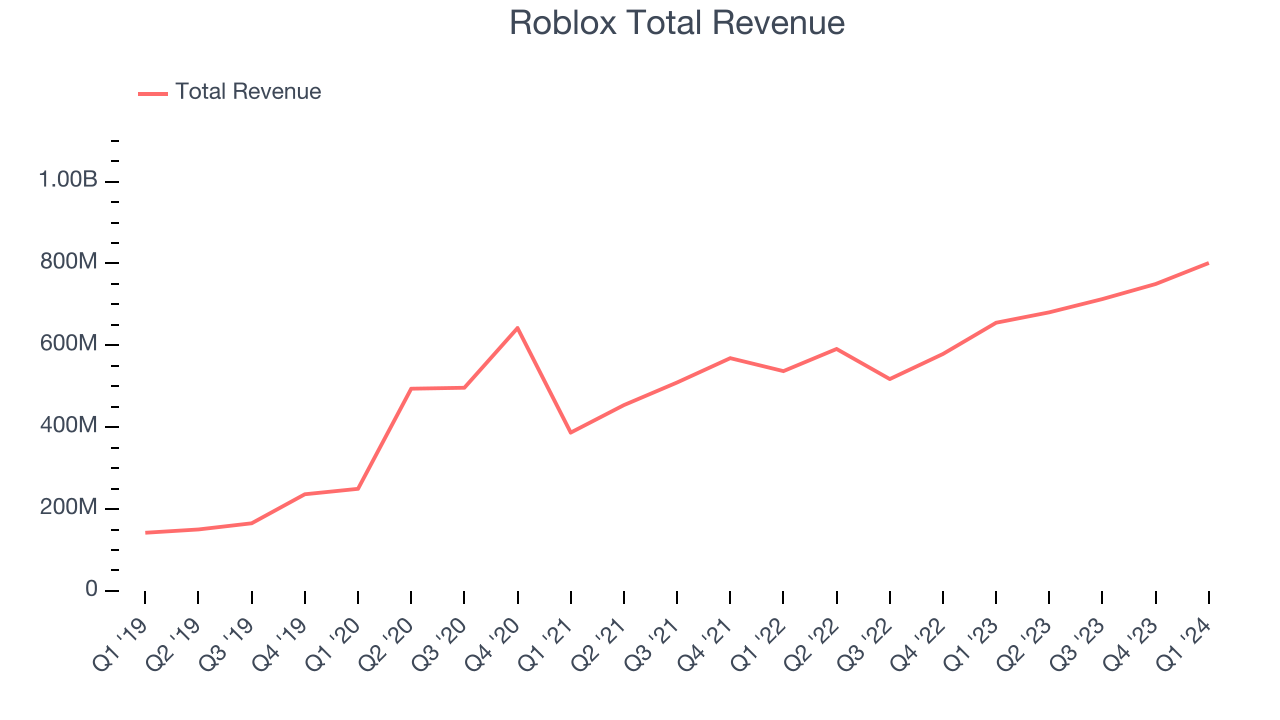
Guidance for the next quarter indicates Roblox is expecting revenue to grow 27.4% year on year to $867.5 million, improving from the 15.1% year-on-year increase it recorded in the comparable quarter last year. Ahead of the earnings results, analysts were projecting sales to grow 49.5% over the next 12 months.
Pricing Power
A company's gross profit margin has a major impact on its ability to exert pricing power, develop new products, and invest in marketing. These factors may ultimately determine the winner in a competitive market, making it a critical metric to track for the long-term investor.
Roblox's gross profit margin, which tells us how much money the company gets to keep after covering the base cost of its products and services, came in at 24.1% this quarter, up 7.3 percentage points year on year.
For gaming businesses like Roblox, these aforementioned costs typically include royalties to sports leagues or celebrities featured in games, fees paid to Alphabet or Apple for games downloaded in their digital app stores, and data center and bandwidth expenses associated with delivering games over the internet. After paying for these expenses, Roblox had $0.24 for every $1 in revenue to invest in marketing, talent, and the development of new products and services.
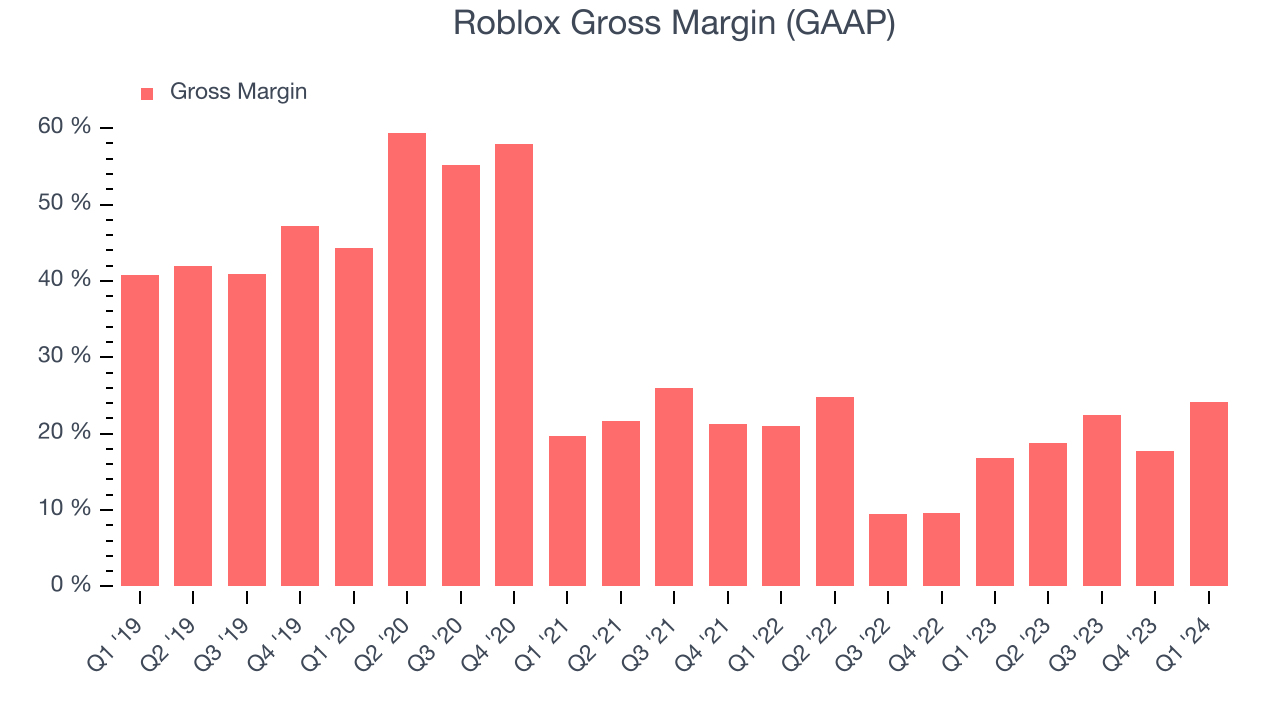
Roblox's gross margins have been trending up over the last 12 months, averaging 20.9%. This is a welcome development, as Roblox's margins are below the industry average, and rising margins could suggest improved demand and pricing power.
User Acquisition Efficiency
Consumer internet businesses like Roblox grow from a combination of product virality, paid advertisement, and incentives (unlike enterprise software products, which are often sold by dedicated sales teams).
Roblox is very efficient at acquiring new users, spending only 26% of its gross profit on sales and marketing expenses over the last year. This efficiency indicates that it has a strong brand reputation and customer acquisition advantages from scale, giving Roblox the freedom to invest its resources into new growth initiatives while maintaining optionality.
Profitability & Free Cash Flow
Investors frequently analyze operating income to understand a business's core profitability. Similar to operating income, adjusted EBITDA is the most common profitability metric for consumer internet companies because it removes various one-time or non-cash expenses, offering a more normalized view of a company's profit potential.
This quarter, Roblox's EBITDA came in at negative $6.90 million, resulting in a negative 0.9% margin. The company has also shown above-average profitability for a consumer internet business over the last four quarters, with average EBITDA margins of 12.6%.
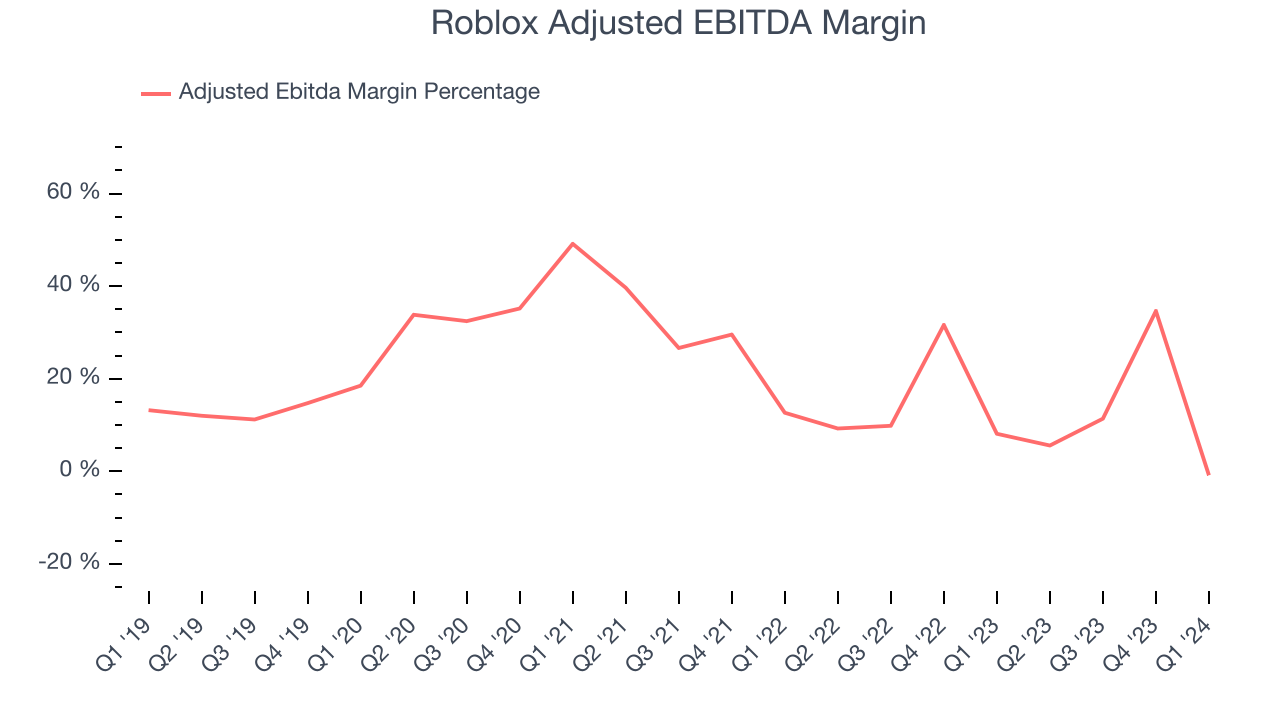
If you've followed StockStory for a while, you know that we emphasize free cash flow. Why, you ask? We believe that in the end, cash is king, and you can't use accounting profits to pay the bills. Roblox's free cash flow came in at $191.1 million in Q1, up 133% year on year.
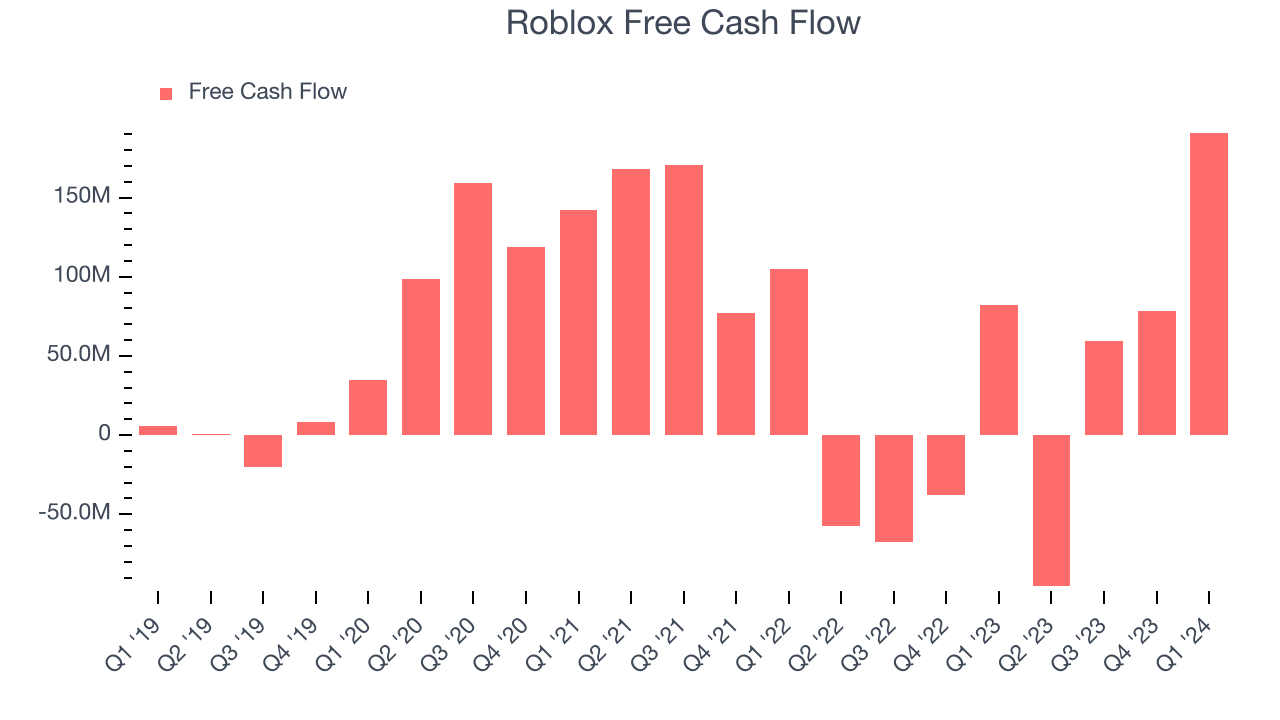
Roblox has generated $233.2 million in free cash flow over the last 12 months, a solid 7.9% of revenue. This strong FCF margin stems from its asset-lite business model, giving it optionality and plenty of cash to reinvest in its business.
Key Takeaways from Roblox's Q1 Results
We struggled to find many strong positives in these results. Its full-year bookings guidance of 15% year-on-year growth missed analysts' expectations, and investors are punishing the stock because management said it would grow at 20%+ annually for the next few years at its November 2023 Investor Day. On top of that, the company announced it would start calculating adjusted EBITDA differently, raising some questions. Overall, the results could have been better. The company is down 29.3% on the results and currently trades at $27.6 per share.
Is Now The Time?
When considering an investment in Roblox, investors should take into account its valuation and business qualities as well as what's happened in the latest quarter.
Although we have other favorites, we understand the arguments that Roblox isn't a bad business. Its revenue growth has been decent over the last three years, and growth is expected to increase in the short term. And while its gross margins make it extremely difficult to reach positive operating profits compared to other consumer internet businesses, the good news is its user acquisition efficiency is best in class.
The market is certainly expecting long-term growth from Roblox given its EV-to-EBITDA ratio based on the next 12 months of 40.5x is higher than many other consumer internet companies. There are things to like about Roblox and there's no doubt it's a bit of a market darling, at least for some. But it seems there's a lot of optimism already priced in and we wonder whether there might be better opportunities elsewhere.
Wall Street analysts covering the company had a one-year price target of $50.34 per share right before these results (compared to the current share price of $27.60).
To get the best start with StockStory check out our most recent Stock picks, and then sign up to our earnings alerts by adding companies to your watchlist here. We typically have the quarterly earnings results analyzed within seconds of the data being released, and especially for the companies reporting pre-market, this often gives investors the chance to react to the results before the market has fully absorbed the information.
